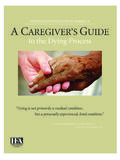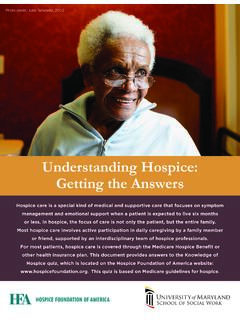Transcription of to the dying process - Hospice Foundation
1 Hospice Foundation oF americaA cAregiver s guide to the dying Process1to the dying process dying is not primarily a medical condition, but a personally experienced, lived condition. WilliAm BArtholme, m. d. 1997, Kansas city Died of Cancer of the esophagus, 2001hosPice Foundation oF AmericAA cAregiver s guideHOSPICE FOUNDATIONOF AMERICAto the dying processhosPice Foundation oF AmericAA cAregiver s guideHOSPICE FOUNDATIONOF AMERICAH ospice Foundation oF americaA cAregiver s guide to the dying Process1 Introduction ..2 Section 1: What to expect When someone is dying ..3the last months of life ..3 the final days and hours ..3 Section 2: What You can do ..5talking and listening ..5 eating and drinking ..6 communicating with doctors, nurses and other professionals ..6 Section 3: Goals of care and Facing tough decisions.
2 7 Goals of care ..7 Health care decision-making ..7 tube feeding and intravenous or subcutaneous fluids ..8 cardiopulmonary resuscitation ..8 mechanical ventilation ..9 stopping treatment aimed at curing the disease ..9 Section 4: spiritual and existential concerns ..11 pain ..11 shortness of Breath (dyspnea) ..14 nausea and Vomiting ..14 Bowel and bladder problems ..15 anxiety ..16 depression ..17 anger ..18 spiritual concerns ..18 Section 5: What about You the caregiver? ..19 emotional reactions ..19 physical reactions ..20 support networks ..20 spiritual or existential reactions ..21 Grief ..21 Section 6: resources ..23 25 conclusion ..26 about this Booklet ..26 contentsHospice Foundation oF america2A cAregiver s guide to the dying ProcessHospice Foundation oF americaA cAregiver s guide to the dying Process3as you care for a dying loved one, understanding the physi-cal and emotional changes that occur during illness and death will help you provide meaningful and effective sup-port.
3 In this section, we present a general description of what you might expect to happen physically and emotionally. For more detailed information about specific symptoms and how they can be managed, turn to section last months of lifein the last 6 to 12 months before death, people with a pro-gressive, debilitating disease commonly experience certain physical symptoms. many people, as they approach the end of life, will become less active and experience chronic fatigue or weakness. Weight loss and diminished appetite are also common. many people experience increasing pain which may be diffuse or in specific areas. other common physical symptoms include shortness of breath, even though they are moving little, or tingling in the hands and feet usually due to disordered nerve function. all of these together generate increasing physical your loved one has an advanced disease, these and other physical symptoms specific to the illness may be pronounced.
4 In addition, skin may become thin and begin to break down, causing irritation or open sores. Bed sores may form when the person sits or lies down most of the day without chang-ing position. as time goes by, many people lose the ability to control their bladder or bowels. this is often distressing for both the dying person and the the final 6 to 12 months of life, people often go through emotional changes as well . caregivers who understand this can help relieve the worries and stresses of the person who is the reality of approaching death sets in, people tend to experience a variety of emotions ranging from anger, anxiety, or depression to feelings of acceptance and contentment. they may become less interested in the world around them and withdraw into themselves. sometimes this is due to sadness and a sense of loss, but it may also be a healthy way of preparing to leave their world.
5 Many people fear becoming a burden on loved ones and may feel guilty or resentful. While it is common for people nearing the end of life to be moody, dying may be a time of revelation and profound addition to physical and emotional changes, many people near the end of life begin thinking about the meaning and purpose of life in general, and of their life in particular. they often think about how they have lived and who they are, resulting in feelings of either contentment or discom-fort. For many, there is sense of heightened spirituality. they may feel closer than ever to a supreme being or spiritual power, or they may feel rejected by this entity. some people find religious meaning in the physical suffering that can accompany dying and may feel that suffering on earth is rewarded in the final days and hoursall dying experiences are unique and influenced by many factors, such as the particular illness and the types of med-ications being taken, but there are some physical changes that are fairly common.
6 For some, this process may take weeks; for others, only a few days or most dying persons, activity decreases significantly in the final days and hours of life. they speak and move less and may not respond to questions or show little interest in their surroundings. they have little, if any, desire to eat or you hold their hand, you may notice that they feel cold. When a person is dying his or her body temperature can go down by a degree or more. Blood pressure will also gradu-ally lower and blood flow to the hands and feet will Caregiver s Guide to the dying process is intended for anyone who is caring for a person near the end of life. our goal is to help make your experi-ence as meaningful and manageable as possible. many who are caring for a terminally ill person have never done so before. You may feel fright-ened, confused, and overwhelmed. it is hard to know and accept that someone we care for is near the end of life.
7 Caregiving is difficult, but it can also be rewarding. caregivers tell us that they are both exhausted and uplifted by the task of caring for someone near the end of life, and when it is over, most of them say they are grateful they could do each person and each caregiver, the path through end of life to death is different. With this booklet, Hospice Foundation of america hopes to provide you, the care-giver, with knowledge and understanding to guide you through caring for your terminally ill loved booklet is divided into 6 sections. in the first section, we provide an overview of the physical, emotional, psychological and spiritual changes that are often seen in the last months or year of life. We also describe common changes in the final days and hours prior to the second section, we discuss what you, the caregiver, can do to ease physical and emotional discomfort.
8 In addition, we offer suggestions for how you can communicate effec-tively with health care the third section, we introduce ideas about the changing goals of care as a person approaches the end of life. We also discuss some of the difficult health care decisions that arise and offer information that may help you think through these the fourth section, we provide more detail on specific symptoms physical and emotional common near the end of life. We describe each symptom and common treatments, and suggest when you may want to call on professionals to fifth section is about you, the caregiver. We discuss what you may experience as your loved one approaches death, and suggest ways to take care of the sixth and last section, we list resources such as books and websites where you can find additional covered in this Bookletdescriptions of the physical, emotional and 0spiritual changes occurring near the end of life, to help you understand what is happening;suggestions for what you, as the caregiver, can do 0to ease physical and emotional distress and make the dying person as comfortable as possible;information to help you, as the caregiver, 0communicate effectively with doctors, nurses and other healthcare professionals.
9 And reflections on how you might feel as the 0caregiver for someone who is dying and ideas for how to care for caregiver s Guide to the dying processsection 1:What to expect When someone is dyingHospice Foundation oF america4A cAregiver s guide to the dying ProcessHospice Foundation oF americaA cAregiver s guide to the dying Process5 Because family members and other caregivers may not feel prepared to handle the events and changes that occur near life s end, we offer the following suggestions from Hospice physicians, nurses, social workers, chaplains and aides with many years of experience caring for dying people. in most cases, health care professionals will be responsible for treating the physical symptoms associated with serious illness toward the end of life. (in section 4, we will explain the treatments for common symptoms.) But you, the caregiver, will be complementing the care of professionals with personal attention and this section, we focus not on specific symptoms, but rather on general types of support that tend to fall on you, the non-professional caregiver.
10 We are not suggesting that this is all that can be done, or that all of our suggestions are appropriate in your particular case. every situation is different and we can only offer advice based on collec-tive experience. We hope the ideas presented here from experienced caregivers will help you think about how you can best care for your loved and listening as the end of life approaches, you can assure your loved one that they will be cared for and will not be abandoned. You can provide them with the opportunity to talk about their wishes and concerns or their reflections on the illness and what it means to have only a short time to live. Just talking about what they are thinking, feeling, and needing can be very comforting. dying people oftentimes want to tell their story, to remind themselves and others of who they are and what they value in their life. they may need time to reflect on and to grieve past and present losses as well as explore their mortality and spirituality.





